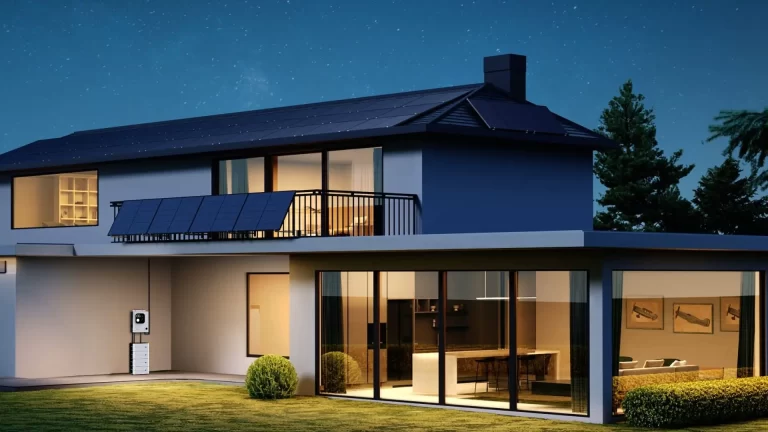近年、世界の太陽エネルギー貯蔵市場は急速な成長を遂げている。再生可能エネルギーに対する需要の高まり、特に太陽光発電の普及に伴い、エネルギー貯蔵システムはエネルギー産業にとって極めて重要な要素となっている。これらのシステムは、住宅、商業、工業の各分野におけるエネルギー利用の柔軟性と安定性を高め、カーボンニュートラル目標に不可欠なサポートを提供している。しかし、太陽光エネルギー貯蔵の専門用語や専門的な概念は、多くのB2B顧客にとってなじみが薄いかもしれない。この記事は、太陽エネルギー貯蔵分野における一般的な用語を明確にし、世界中の顧客がこれらのシステムを明確に理解し、十分な情報に基づいた製品選択ができるようにすることを目的としています。

太陽エネルギー貯蔵における主要用語の説明
バッテリー管理システム(BMS)
- 定義:バッテリー管理システム(BMS)は蓄電システムの中核をなすコンポーネントで、バッテリーの性能を監視・管理する。
- 機能:BMSは電圧、温度、充放電電流を監視し、異常検知やアラームなどの機能を備えています。バッテリー性能を最適化し、過充電、過放電、過熱を防ぎ、バッテリー寿命を延ばします。
- 重要性:BMSがシステムの安全性を確保します。SOTTLOTのDPE-5Kバッテリーシステムのようなマルチモジュールシステムでは、BMSがパラレルモニタリングとマルチパラメータトラッキングを可能にし、複雑な環境でも効率的で安全なオペレーションを実現します。
インバーター
- 定義:インバーターは直流(DC)を交流(AC)に変換する重要な装置である。ソーラーパネルやバッテリーは直流を生成しますが、ほとんどの電化製品は交流を必要とするため、インバーターは安定した交流出力を保証します。
- 機能:インバーターは蓄電システムのブリッジとして機能し、蓄電された直流電力を使用可能な交流電力に変換する。高品質のインバーターはまた、電流変動による機器の損傷を防ぐため、電力出力を調整します。
- 重要性:インバーターの品質はシステムの効率と出力の安定性に直接影響します。SOTTLOTのシステムは、高効率インバーターを使用し、スムーズな電力出力を保証し、商業用および住宅用の様々な用途に適しています。
最大電力点追従(MPPT)
- 定義:MPPTは、さまざまな気象条件下で太陽光発電システムの出力効率を高める電力最適化技術である。
- 機能:MPPTシステムは、太陽光と気温の変化に基づいて動作点を調整し、最適な性能を確保して出力を最大化します。
- 重要性:MPPTは、特に照明が安定しない地域において、システム効率を向上させる上で重要な役割を果たします。MPPTは、変動する条件下でもソーラーパネルの性能を維持することを可能にし、エネルギー効率を大幅に向上させます。
グリッド接続およびオフグリッドシステム
- 定義:グリッド接続型(オングリッド)システムは公共グリッドに接続し、オフグリッドシステムはグリッドから独立した自給自足のシステムである。
- アプリケーション:系統連系システムは、安定した送電網がある地域に適しており、余剰電力を送電網に供給することで双方向のエネルギー利用を可能にする。オフグリッドシステムは、信頼できる送電網へのアクセスがない遠隔地に最適で、スタンドアロンで電力を供給します。
- 重要性:適切なシステムタイプを選択することで、電力コストを最適化し、持続可能な電力供給を実現します。SOTTLOTの製品は、オングリッドとオフグリッドの両方の構成をサポートし、多様なニーズに適応するソリューションを提供します。
リチウム電池(LiFePO4)
- 定義:リン酸鉄リチウム(LiFePO4)電池は、効率的で安全、かつ耐久性のあるエネルギー貯蔵オプションとして、太陽光発電システムで広く使用されています。
- 特徴:LiFePO4バッテリーは、長寿命、高温耐性、適度なエネルギー密度を提供します。熱的・化学的に安定しており、熱暴走のリスクを低減し、安全性を確保します。
- 重要性:LiFePO4バッテリーの信頼性と寿命は、エネルギー貯蔵システムに理想的です。SOTTLOTのDPE-5Kシステムは、過酷な条件下でも長期間安定した性能を発揮するこのバッテリーを採用しています。
定格電力とサージ電力
- 定義:定格電力は、システムが長時間維持できる安定した電力出力であり、サージ電力は、システムが短時間に処理できる最大電力である。
- アプリケーション:定格電力は連続的な電力需要に対応し、サージ電力は短時間のバースト電力に対応し、機器の始動時などの高需要時の過負荷を防止します。
- 重要性:定格電力とサージ電力を理解することで、システムを正しく構成し、接続された機器の適切な動作を保証します。
7.並列接続と直列接続
- 定義:並列接続はシステム容量を増やし、直列接続はシステム電圧を上げる。
- アプリケーション:並列接続は大容量の蓄電システムに適しており、複数のバッテリーで総容量を増やすことができます。直列接続は電圧を上げることで、高出力を必要とする用途に最適です。
- 重要性:正しい接続方法を選択することで、様々なニーズに対応したシステムパフォーマンスを最適化します。SOTTLOTのストレージ製品は、並列構成と直列構成の両方をサポートしており、様々な産業および商業環境で柔軟に使用することができます。
キーワードに基づく製品選択の推奨
適切なエネルギー貯蔵製品の選択は、特定のニーズや用途によって異なる。以下は、一般的な顧客タイプに関する検討事項である:
- 工業用顧客:定格電力、サージ電力、インバータの品質に重点を置く。産業用途では、高い電力とシステムの安定性が求められるからである。
- 法人のお客様:大容量のリチウムイオンバッテリーシステムが理想的で、電力の安定性と効率を確保するMPPTとBMS機能を備えています。
- ホームユーザー:BMSの安全性、インバータの品質、オングリッド/オフグリッドオプションに重点を置くべきである。SOTTLOTのDPE-5Kシステムは、モジュール設計と柔軟な設置が可能で、住宅ユーザーにとって便利です。
SOTTLOTの製品は、BMS、MPPT、インバーターの性能に優れ、各業界に高品質のソリューションを提供しています。
SOTTLOTはどのように顧客のエネルギー貯蔵技術への理解を助けているか
太陽エネルギー貯蔵のリーダーとして、SOTTLOTは先進的な製品を提供するだけでなく、お客様にその技術を十分に理解していただくよう努めています。SOTTLOTは次のような形でお客様をサポートします:
- 詳細技術マニュアル:各製品には包括的なマニュアルが付属しており、お客様がシステムの機能と操作をすぐに理解できるようになっています。
- トレーニングと技術サポート:SOTTLOTのグローバル・テクニカル・チームは、専門的なトレーニングとサポートを提供し、お客様にシステムの操作とメンテナンスを熟知していただきます。
太陽エネルギー貯蔵システムには多くの専門用語や概念が含まれており、これらの用語を理解することは、お客様が十分な情報を得た上で選択することに役立ちます。SOTTLOTの技術的専門知識とグローバルサポートは、専門用語の説明から製品の選択まで、お客様をサポートします。エネルギー貯蔵システムに関する知識を深め、専門的なソリューションのためにSOTTLOTの技術リソースを活用することで、長期にわたる安定したクリーンエネルギーアプリケーションを可能にします。




